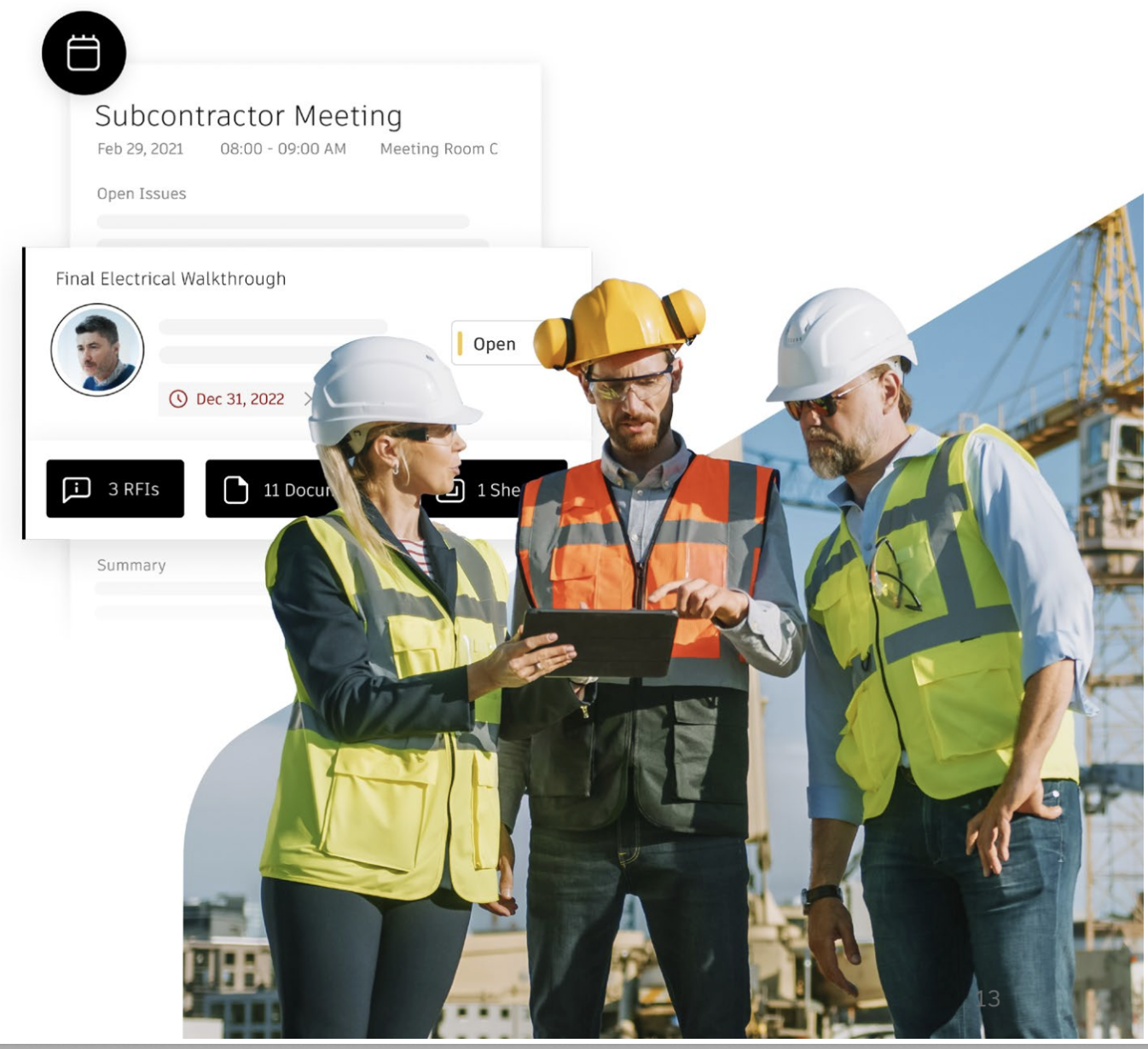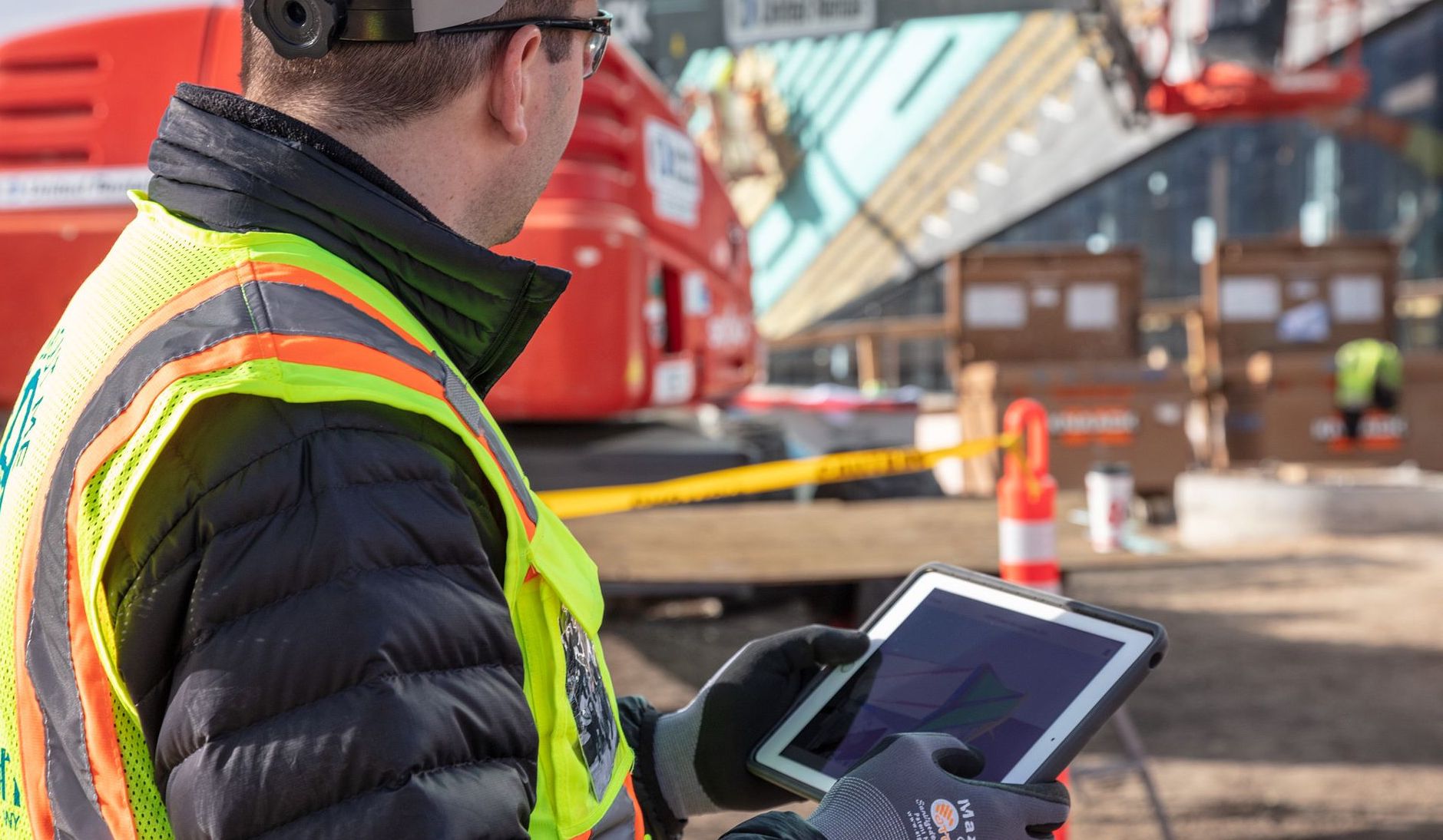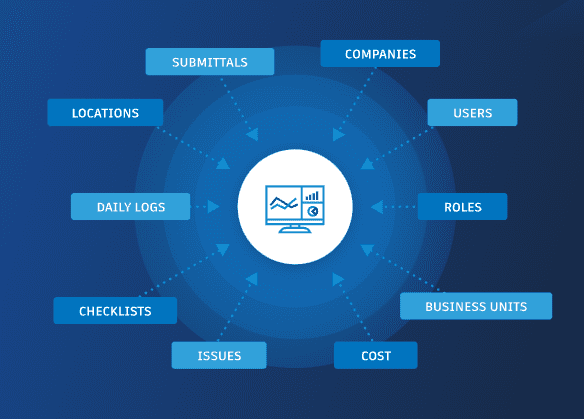
FREE GUIDE
The ROI of Construction Project Management Software
In this guide, we’ll cover how you can realize ROI by making every construction workflow more efficient, from RFIs to submittals to schedules.


In this guide, we’ll cover how you can realize ROI by making every construction workflow more efficient, from RFIs to submittals to schedules.


Construction software isn’t new. For years, teams have been using apps and tools to facilitate various stages of projects, including preconstruction, design, and operations.
But the need for construction management software — specifically modern and robust solutions — continues to grow. Projects today are a lot more complex and companies increasingly face pressure to improve construction productivity and profitability.
The right technology (including software) can help construction firms do all that, and most industry players recognize this. Research by USG + U.S. Chamber of Commerce Commercial Construction Index (CCI) found that 78% of contractors believe that advanced tech can increase labor productivity and 75% believe it can improve the management of project schedules.
But before rushing to adopt new tools, it helps to understand what construction management software actually is.
That’s exactly what we’ll tackle below. This post will shed light on the ins and outs of construction management software, including what features to look for and how to select the right one for your company.
Construction management software is essentially connected project technology geared specifically for the construction industry. It’s a tool (or a set of tools) that goes beyond just project management capabilities and enables construction firms to carry out tasks such as managing budgets, ensuring quality and safety programs, setting schedules and timelines, completing quality and safety checklists, storing daily report, communicating and coordinating with stakeholders across the office and the field, and so much more. Basically, the software is the one place to go for all project documentation.
Construction management software automates and streamlines tasks and connects workflows and data across the project lifecycle, so teams can be more efficient and productive.
Looking to level-up your career in construction project management? Take our free Project and Cost Management Master Class.
Construction companies today face significant challenges and the pressure to improve overall productivity and profitability. Fortunately, the right construction management software can help your company do just that.
There are a number of benefits to using construction management software that we’d like to share with you. From reducing risk on a project to making sure you adhere to a specific timeline, these are a few of the major benefits that we think are the best reasons for investing in construction management software.
Construction management software can improve the quality of your projects, along with the experience of everyone involved.
Increased visibility, efficiency, and collaboration all lead to better documentation, fewer defects, and better support for stakeholders — all of which translates to more favorable outcomes.
In your work, the one thing you want to eliminate is uncertainty. With construction software, you can dramatically reduce the risk of disputes, inconsistent reporting and errors, poor documentation, coordination hurdles, safety hazards, and poor labor quality.
How?
Construction management software can help you keep things transparent and standardized.
Construction management software has helped the industry reach a turning point. No longer do people have to rely on legacy programs designed for in-office use; you have the option of using software on the job that is suited to the job.
Research from FMI found that construction professionals spend 35% of their time (over 14 hours per week) on non-productive activities including looking for project information, conflict resolution and dealing with mistakes and rework. Even more frustrating is that these non-optimal activities take away from the more important aspects of a job, like executing the project, communicating with stakeholders, and coordinating with people on site.
Since around 48% of all rework is a result of poor project damage and miscommunications on the job, it’s extremely important for companies to find a remedy to those issues.
Construction management software streamlines various tasks and minimizes issues like human error and missing data. The solution also enables teams to do things quickly and accurately, so tasks are completed faster and stakeholders can devote their efforts towards high-value and profit-generating activities.
Construction project management software improves quality and accuracy of work. In fact, estimates show that around 4 to 6% of the total cost of a project is related to rework (when looking at reported rework and direct costs). If you take into consideration side projects and do-overs that workers have to do, the indirect and direct factors lead to a cost increase of around 9%.
This heightened expense is another reason why construction software is so important. It helps minimize the risk of rework on a project, keeping your project on schedule and protecting your bottom line.
A robust construction management solution gives you the data and insights you need to make more informed decisions. Whether you need to make a call on a specific project or are looking to make high-level and strategic decisions across all your projects, your construction management software should be able to give you the necessary info.
There are a few different features that you’ll want to consider before purchasing construction project management software.
Modern construction management solutions run in the cloud, so teams get information from a single source and have access to data no matter where they are. The software automatically updates, keeping documentation up-to-date and secure. Even new features can be rolled out on the cloud, enabling construction teams to access the latest and greatest in project management tools.
Each of these things is important in today’s fast-paced construction landscape, since your team may be scattered across multiple projects or locations. You may have people in-office as well as some in the field. A cloud-based solution makes sure everyone has the tools they need no matter where they are.
The right tech solution for your company will get everyone on board at the earliest project phases. A strong connection to design lets construction teams pull in valuable data and information to complete better estimates, have a more complete picture of their project, and build better with 3D models on their iPads.
Look for a construction management platform that provides end-to-end solutions throughout the entire project lifecycle (starting in design), so you don’t have to switch to other programs or apps unnecessarily.

There will be a number of phases and activities during your construction project. As you know, everything from the initial design of a project to the final touches are connected. Your technology needs to connect all of that data (and the people working with it, too).
Designers, engineers, owners, field workers, specialty contractors, and operational vendors all need to be on the same page. The right construction management software makes that simpler by making sure each team member has the access they need to tools that help them in their roles.
Another thing you will want out of your technology is for it to be easy to implement. Once it’s implemented, you need to know that people are going to be able to use it.
Not everyone you work with is going to have the same experience with technology, and they will have varying degrees of technical expertise. It’s essential to choose a solution that is user-friendly but still powerful enough to get the job done right.
Choose an interface that is intuitive. That means that when you open your dashboard, you understand what’s in front of you and it’s simple to see how to get the additional information that you’re looking for. Any user who gets access should be able to see all the information and features they need quickly and easily.
On that note, remember that this has to apply not only to your in-office desktop software but also to any technology out in the field, whether it’s on a tablet, phone, or other mobile device.
No two construction projects are the same, and you’re going to need some amount of flexibility in your workflow. Of course, you will need to have some of your general daily procedures done on time regardless of the project, but the way those are done may need to fluctuate from one project to the next.
Your construction management software needs to be able to handle those little nuances, allowing your team to be flexible while still recording all the data you need. A good piece of software enables you to easily customize dashboards, templates, or even workflows, so you have the right documentation and processes to complete your work.
Construction projects don’t happen in a vacuum. It’s important that all the people working on the project are able to communicate and work together to bring those projects to life.
The components of a project have to be tightly knit. In construction technology, that means having software that is connected in a way that lets your processes function seamlessly.
The tools you use need to be able to “speak” to one another, and your workflows should be connected so that data moves freely between systems and from one phase to the next.
All of this helps to make sure your data doesn’t go unnoticed or unused, resulting in your teams being better informed and better able to make solid, data-driven decisions.
The right software will hold all of your data securely. You should find software that offers robust user permission capabilities that allow you to quickly enable or restrict access to information based on each person’s role on the team.
Why use construction project management software? We have a few use cases that you should keep in mind while deciding if it’s right for you.
Quality management benefits from construction project management software. How? It helps to reduce constructability issues onsite. Your team has a better opportunity to avoid rework and identify constructability issues during the preconstruction phase, letting them resolve clashes sooner. Additionally, since the software has cloud-based issue management, everyone stays up to date on the latest changes.
Quality management is also improved with centralized document management, standardized quality controls, and better streamlining during commissioning and handover.
Good software helps improve safety on site as well. Initially, you can use this software to participate in and create better safety plans for all your projects. You can also easily distribute incident reports, safety checklists, and other documents to your team on and off-site.
With cloud-based construction management software, your team can log in from their mobile devices to report safety issues or incidents on site.
Quality software options will let you improve cost control by making cost-related risks more visible. Better forecasting is possible when your data is all in one place, and it’s even better if it’s easily accessible from the cloud.
Good transparency helps you improve cost control. Using a single technological platform, you can keep information in the right hands and make sure all people with the right permissions can see what they need to see at the right time. This enhances collaboration and helps to streamline construction workflows.
Do you want to seamlessly manage RFIs? You can do so and make sure responsibilities are clear for each step of the process with the right construction project management software.
Of course, you can do more than just manage the RFIs. You can connect them across the project’s lifecycle, making it simple to escalate issues to RFIs and RFIs to potential change orders.
It’s easier to complete submittals with the support of automated submittal logs, and you can also initiate submittal requests, manage reviews and approvals, and so much more.
When you’re working on a project, you want to know that you can get all your documentation where you can see it when you need to see it. Streamlining and centralizing document management makes it simpler to organize, distribute, and share and manage your construction files from one centralized location.
Doing this gives you better document control, keeps your teams organized, and helps you standardize document approvals. Whether you want to publish your drawings to the field or gain access to the day’s reviews, a centralized database helps you do this.
Construction schedule management software transforms planning, executing, and managing project. The right solution enables teams to gain real-time visibility into centralized project schedules in the cloud, allowing project stakeholders to collaborate and manage changes with the most up-to-date information.
Look for software that enables key scheduling features like:
Read more: Construction Schedule Management Software: Keep Your Project on Track
Whether you’re a contractor or owner, the tracking, installation, and commissioning of construction assets is critical in ensuring a successful project delivery. Asset tracking enables you to manage critical construction assets across the project lifecycle.
When your construction management software is equipped with asset tracking, you enhance project visibility, accelerate commissioning, and improve turnover.
Even better, some new software options enable you to visually markup 2D sheets and track asset progress itself. This keeps office teams updated while empowering people in the field to forecast their productivity and quickly adjust to scheduling changes.
Learn more: Tracking Your Assets to Hit Schedule and Win Contracts
Make all your meetings more productive by using construction technology to communicate and collaborate more effectively. You can centralize meetings when your software is on the cloud, allowing people to call in from anywhere they have internet access.
You can also:
With this kind of technology, it is easier to document key decisions, so you can reflect back on them when you need to. Again, with cloud technology, you can access this information from anywhere you have a connection, so you can always be up to date on the latest developments.
Data isn’t as helpful if you can’t harness its full potential. With construction project management software, it’s possible to get a holistic view of each project you’re working on with custom dashboards. But at a basic level, a great solution will streamline data between teams and workflows. This means easy-to-use tools to share files and sheets, set up automations, and link information project to project including stakeholders across accounts.
Furthermore, future-forward software will help you identify and mitigate risks using predictive analytics and make it easy to get reports about the content you need to know. Beneficially, you can automate reports with your software and take your data analysis and risk prevention to the next level with predictive technology.

Ready to choose a new construction management solution? The following steps will ensure that you select the best software and that your implementation process goes smoothly.
Before going “out there” to find a solution, do an internal audit of your existing tech stack. List and evaluate the tools you’re already using and determine which ones to keep and which solutions can be replaced. Ask your teams about the software that they rely on and what’s missing.
You should also consider the different functionalities of your solutions. If you’re using multiple apps for specific tasks, would it be possible to replace them with a solution that offers the same features on one platform?
If there are apps that you absolutely need to keep using, take note and make sure they’re integrate-able with other tools.
It also helps to identify gaps in your technology. Do you still have manual processes in place? Do you find yourself having to re-enter the same information into different systems? These are tell-tale signs that you need modern software to automate and integrate your workflows.
Once you’ve done your internal research, gather your findings and use them to evaluate the different options on the market.
Construction projects involve plenty of people and moving parts, so getting up and running should be a well-thought-out process. It also means selecting a partner--not just a vendor--to guide you along the onboarding process and to scale with with.
There’s a chance that the tool won’t be adopted by your teams, so it’s best to start a pilot program and give your partner a test run before purchasing the software.
Security is another important factor. If you’re holding a construction request for proposal (RFP) process, be sure to include questions that shed light on the partner’s security policies.
The people who will actually be using the software should be included in the selection and implementation process. Their involvement will not only help you choose the right software, but they can ensure wide adoption of the new solution.
As such, it’s important to get buy-in from users and senior staff early on. Get their input before making a purchase decision and see to it that stakeholders are comfortable with the program.
Once you’ve made a decision, thoroughly train everyone who will be using the software. Give them the knowledge and resources they need to get up and running successfully.
It also helps to have internal champions for the software — people who can engage and educate the rest of the organization and encourage them to get on board.
Throughout all of this, it’s important to remember that tech adoption and implementation can take time. So, set realistic timelines for the full roll-out of the solution.
At Autodesk, we offer construction management software made for your individual project and business needs. You can improve transparency and your project workflow much more easily when you have the right tools at your disposal.
Let us introduce you to Autodesk Build. We’ll give you a demo, so you can see how your team can be empowered with better connected teams, data, and workflows.

May we collect and use your data?
Learn more about the Third Party Services we use and our Privacy Statement.May we collect and use your data to tailor your experience?
Explore the benefits of a customized experience by managing your privacy settings for this site or visit our Privacy Statement to learn more about your options.